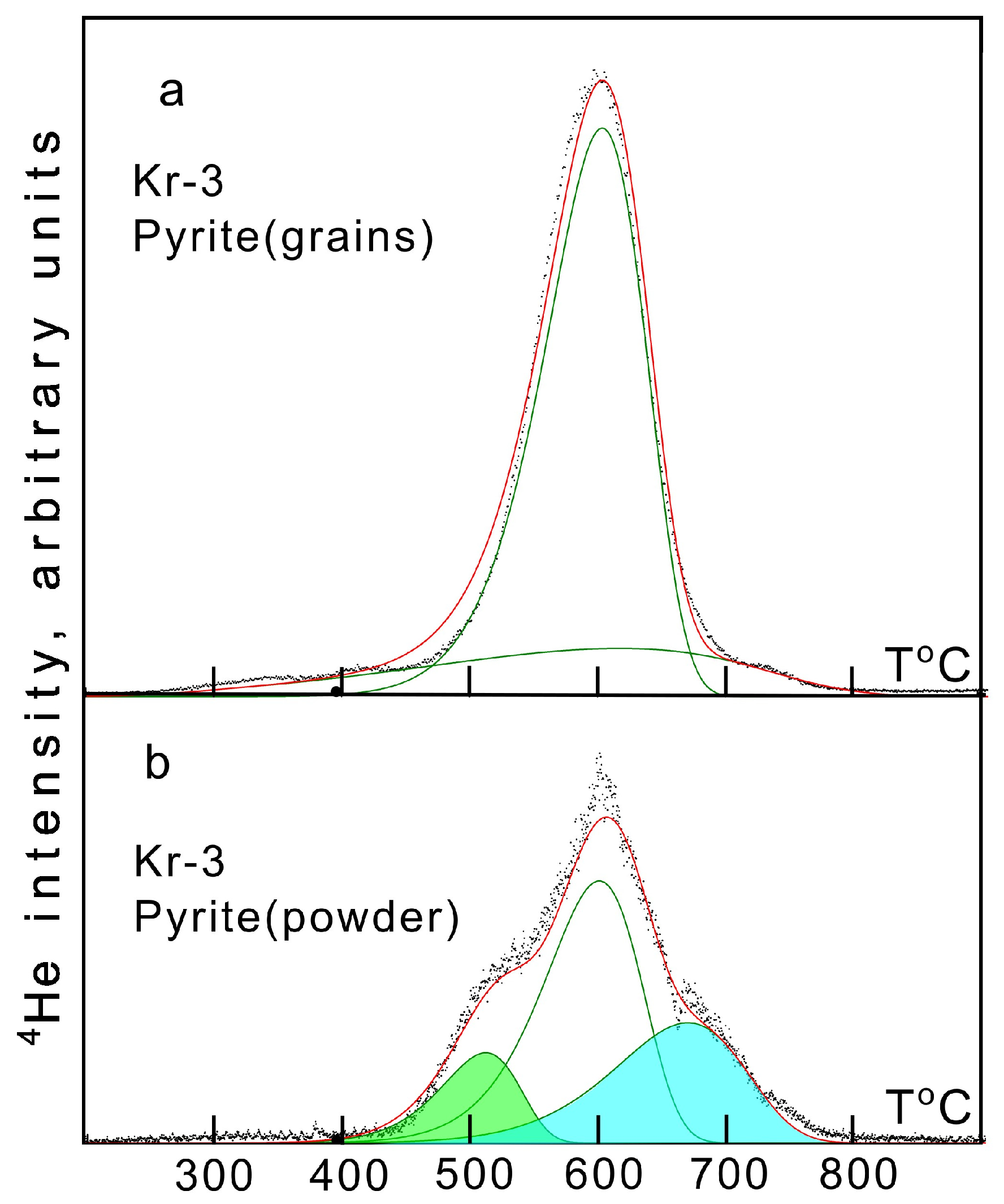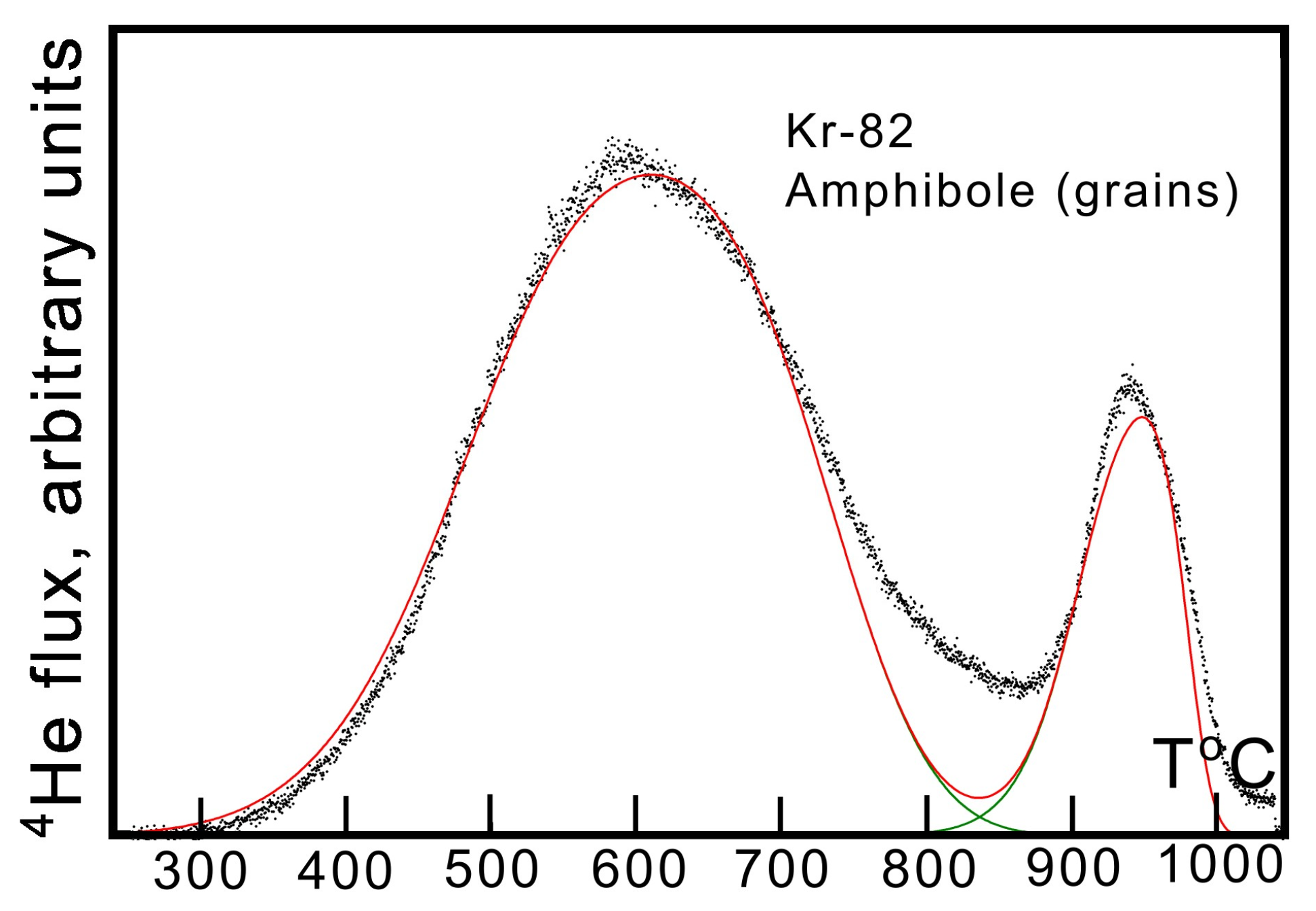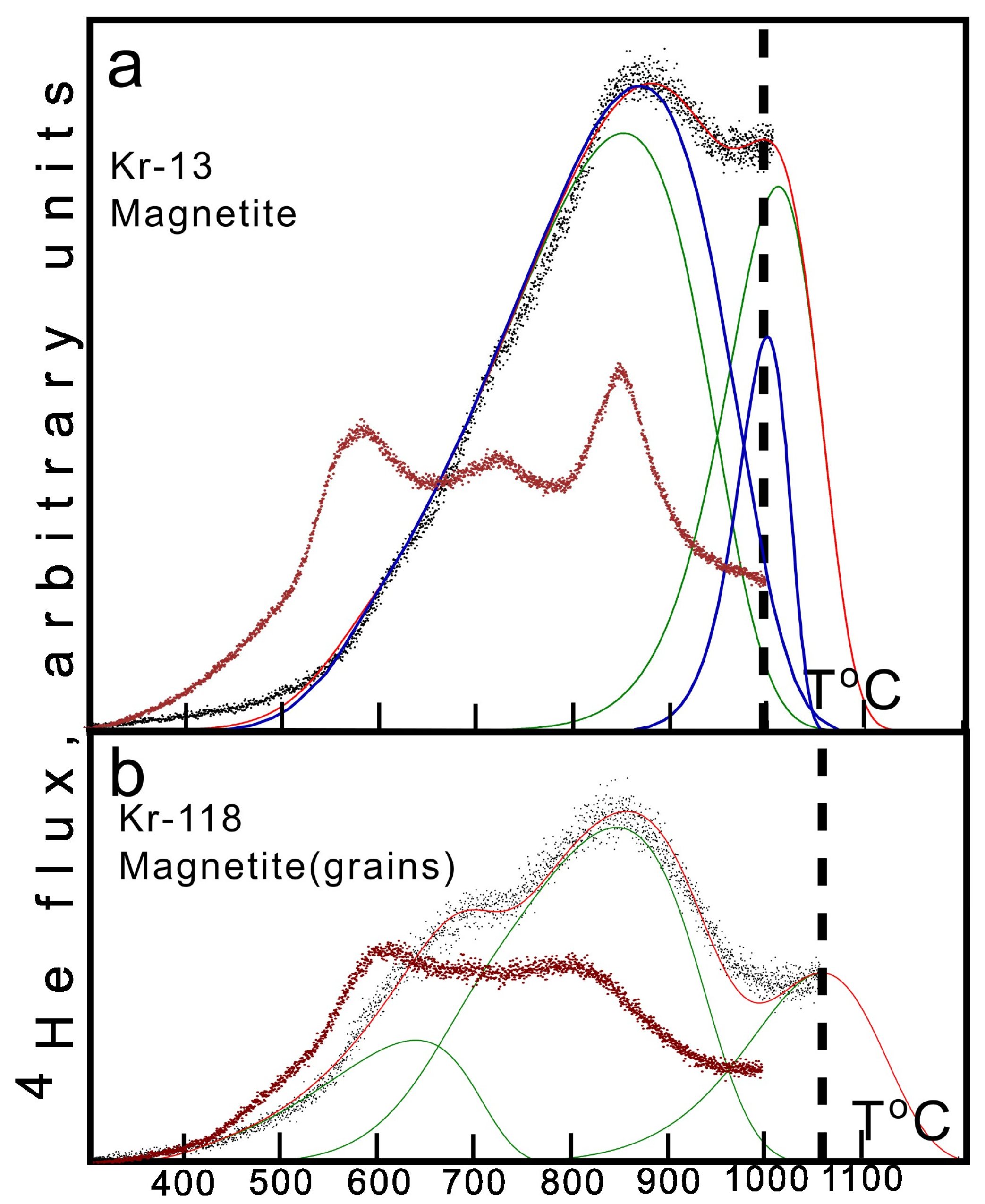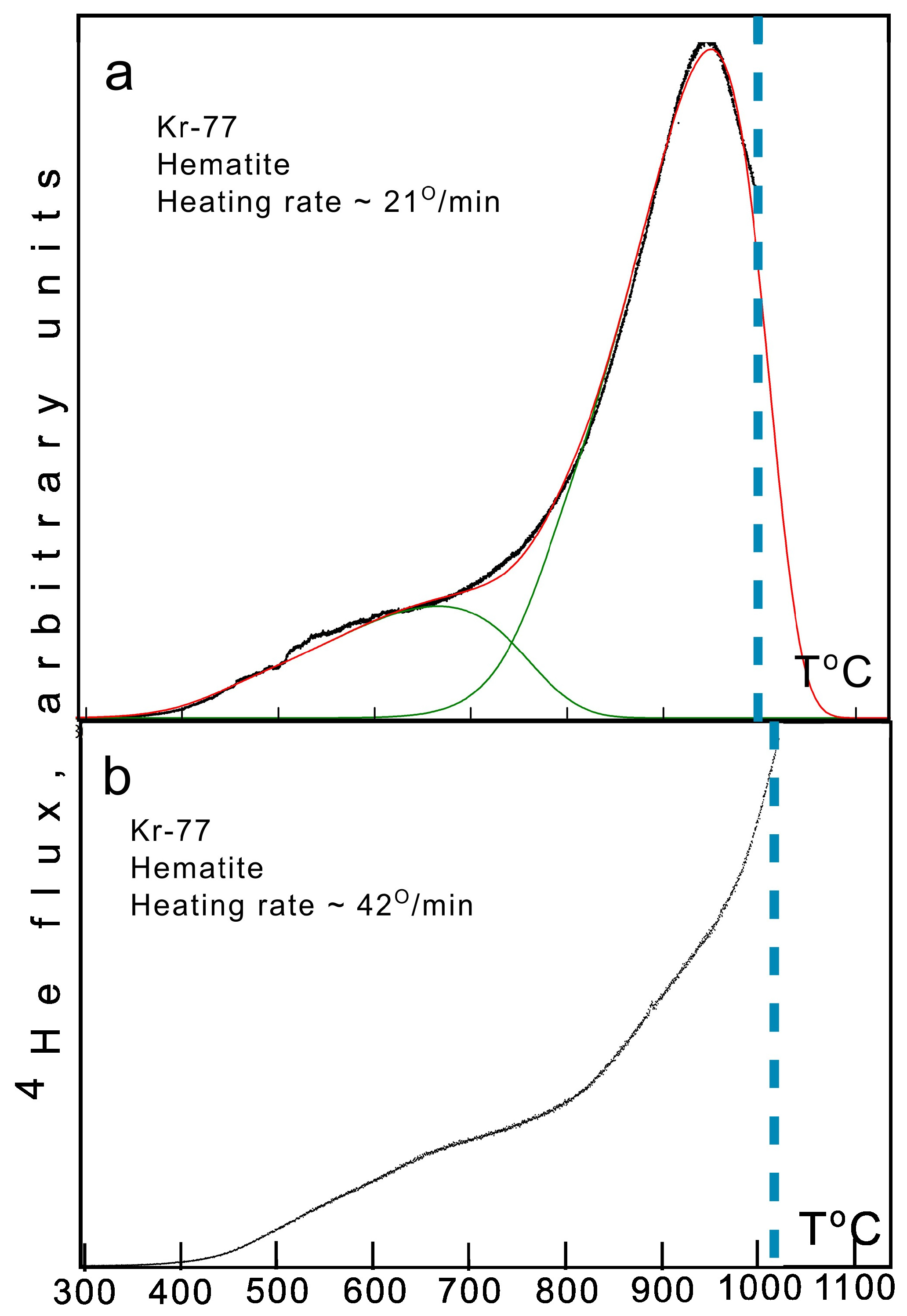Quantifying the Contribution and Mobility of In Situ-Produced Helium in He-Retentive Minerals: A Case Study of the Salla-Kuolajarvi Metasomatic Rocks (Russia)
Abstract
1. Introduction
2. Object of Research
- -
- 1.75 Ga—the age of albitite (U-Pb—rutile; Sm-Nd—whole rock and minerals, Rb-Sr—whole rock and minerals), the lower temperature limit of albitite formation was 400–450 °C;
- -
- 1.62 Ga—formation of chlorite and carbonate metasomatic rocks after albitite and deposition of uraninite (electron microprobe dating of uraninite in albitite from Ozernoe, Rb-Sr—whole rock and minerals from Mayskoe deposit [23]) at a temperature not lower than 300–350 °C;
- -
- 385 Ma—hydrothermal activity, caused by alkaline-carbonate intrusions: recrystallization of uranium minerals (U-Pb—brannerite).
3. Materials and Methods
3.1. Materials
3.2. Methods
3.3. Data Processing
4. Results
4.1. Pyrite
4.2. Amphibole
4.3. Magnetite
4.4. Hematite
5. Discussion
6. Conclusions
- (1)
- Despite the fact that the studied minerals have a metasomatic origin and structures, the actual preservation of helium, e.g., in iron oxides, allows us to count on obtaining significant chronological information.
- (2)
- The geometric method for separating trapped and radiogenic helium has been used for the first time; it needs both verification (calibration) using a priori data and improvement. In particular, IH experiments should be performed up to the complete degassing of the sample, which is sometimes confined to the sample fusion temperature.
- (3)
- Since the proposed approach imposes very few restrictions on the material investigated, processing several samples formed under similar conditions and/or a repeated experiment would be advisable. Such a practice should give an indication of the reliability of age estimates.
- (4)
- The technique proposed may just as well be used for the more accurate quantification of the trapped component. Such an application may prove even more effective in cases where contrast isotopic signatures of the two components are expected.
Author Contributions
Funding
Data Availability Statement
Acknowledgments
Conflicts of Interest
References
- Zeitler, P.K.; Herczig, A.L.; McDougall, I.; Honda, M. U-Th-He dating of apatite: A potential thermochronometer. Geochim. Cosmochim. Acta 1987, 51, 2865–2868. [Google Scholar] [CrossRef]
- Farley, K.A. (U-Th)/He dating: Techniques, calibrations, and applications. Rev. Mineral. Geochem. 2002, 47, 819–844. [Google Scholar] [CrossRef]
- Flowers, R.M.; Zeitler, P.K.; Danišík, M.; Reiners, P.W.; Gautheron, C.; Ketcham, R.A.; Metcalf, J.R.; Stockli, D.F.; Enkelmann, E.; Brown, R.W. (U-Th)/He chronology: Part 1. Data, uncertainty, and reporting. GSA Bull. 2023, 135, 104–136. [Google Scholar] [CrossRef]
- Ault, A.K.; Gautheron, C.; King, G.E. Innovations in (U–Th)/He, fission track, and trapped charge thermochronometry with applications to earthquakes, weathering, surface-mantle connections, and the growth and decay of mountains. Tectonics 2019, 38, 3705–3739. [Google Scholar] [CrossRef]
- Farley, K.A.; Wolf, R.A.; Silver, L.T. The effects of longalpha-stopping distances on (U–Th)/He ages. Geochim. Cosmochim. Acta 1996, 60, 4223–4229. [Google Scholar] [CrossRef]
- Murray, K.E.; Orme, D.A.; Reiners, P.W. Effects of U–Th-rich grain boundary phases on apatite helium ages. Chem. Geol. 2014, 390, 135–151. [Google Scholar] [CrossRef]
- Ketcham, R.A.; Gautheron, C.; Tassan-Got, L. Accounting for long alpha-particle stopping distances in(U–Th–Sm)/He geochronology: Refinement of the base-line case. Geochim. Cosmochim. Acta 2011, 75, 7779–7791. [Google Scholar] [CrossRef]
- Tolstikhin, I.; Tarakanov, S.; Kolobov, V.; Gannibal, M. Mobility of Radiogenic Helium in Amphibole. Minerals 2021, 11, 27. [Google Scholar] [CrossRef]
- Gerling, E.K. Current State of the Argon Method for Determining Age and Its Application in Geology; Publishing House of the USSR Academy of Sciences: Saint Petersburg, Russia, 1961. (In Russian) [Google Scholar]
- Levskii, L.K. Diffusion of helium from stony meteorites. Geochemistry 1963, 6, 556–561. [Google Scholar]
- Fechtig, H.; Kalbitzer, S. The diffusion of argon in potassium-bearing solids. In Potassium–Argon Dating; Schaefer, O.A., Zahringer, J., Eds.; Springer: Berlin/Heidelberg, Germany, 1966; pp. 68–107. [Google Scholar]
- Tolstikhin, I.; Kamensky, I.; Tarakanov, S.; Kramers, J.; Pekala, M.; Skiba, V.; Gannibal, M.; Novikov, D. Noble gas isotope sites and mobility in mafic rocks and olivine. Geochim. Cosmochim. Acta 2010, 74, 1436–1447. [Google Scholar] [CrossRef]
- McDannell, K.; Zeitler, P.; Janes, D.; Idleman, B.; Fayon, A. Screening apatites for (U-Th)/He thermochronometry via continuous ramped heating: He age components and implications for age dispersion. Geochim. Cosmochim. Acta 2018, 223, 90–106. [Google Scholar] [CrossRef]
- Idleman, B.D.; Zeitler, P.K.; McDannell, K.T. Characterization of helium release from apatite by continuous ramped heating. Chem. Geol. 2018, 476, 223–232. [Google Scholar] [CrossRef]
- Guo, H.; Zeitler, P.K.; Bruce, D.; Idleman, B.; Fayon, A.; Fitzgerald, P.G.; McDannell, K.T. Helium diffusion systematics inferred from continuous ramped heating analysis of Transantarctic Mountains apatites showing age overdispersion. Geochim. Cosmochim. Acta 2021, 310, 113–130. [Google Scholar] [CrossRef]
- Tolstikhin, I.N.; Kamensky, I.L.; Marty, B.; Nivin, V.A.; Vetrin, V.R.; Balaganskaya, E.G.; Ikorsky, S.V.; Gannibal, M.A.; Weiss, D.; Verhulst, A.; et al. Rare gas isotopes and parent trace elements in ultrabasic-alkaline-carbonatite complexes, Kola Peninsula: Identification of lower mantle plume component. Geochim. Cosmochim. Acta 2002, 66, 881–901. [Google Scholar] [CrossRef]
- Kalinin, A.A. Tellurium and Selenium Mineralogy of Gold Deposits in Northern Fennoscandia. Minerals 2021, 11, 574. [Google Scholar] [CrossRef]
- Kulikov, V.S.; Kulikova, V.V. The Kuolajarvi synclinorium: A new view on the geological structure and combined cross section. In Trudy Karel’skogo Nauchnogo Tsentra RAN; Karel’skiy Nauchniy Tsentr RAN: Petrozavodsk, Russia, 2014; pp. 28–38. (In Russian) [Google Scholar]
- Hölttä, P.; Heilimo, E.; Huhma, H.; Kontinen, A.; Mertanen, S.; Mikkola, P.; Paavola, J.; Peltonen, P.; Semprich, J.; Slabunov, A.; et al. The Archaean of the Karelia Province in Finland; Special Paper 54; Geological Survey of Finland: Espoo, Finland, 2012; pp. 21–73. [Google Scholar]
- Kalinin, A.A. Stages of Gold Deposits Formation in the Precambrian of the North-Eastern Fennoscandia. Minerals 2022, 12, 537. [Google Scholar] [CrossRef]
- Kalinin, A.A. Gold in Metamorphic Complexes of the North-Eastern Part of the Fennoscandian Shield; Federal Research Centre ‘Kola Science Centre’: Apatity, Russia, 2018; 250p. (In Russian) [Google Scholar]
- Kalinin, A.A.; Kaulina, T.V.; Lyalina, L.M.; Elizarov, D.V.; Serov, P.A. Stages in the formation of uranium mineralization in the Salla-Kuolajarvinskaya zone (Northern Karelia): Geological and isotope geochronological data. Geol. Ore Depos. 2016, 58, 594–599. [Google Scholar] [CrossRef]
- Safonov, Y.G.; Volkov, A.V.; Volfson, A.A.; Genkin, A.D.; Krylova, T.L.; Chugaev, A.V. The Mayskoye gold-quartz deposit, Northern Karelia: Geological and mineralogical-geochemical peculiar features and genesis issues. Geol. Ore Depos. 2003, 45, 429–451. [Google Scholar]
- Crank, J. The Mathematics of Diffusion, 2nd ed.; Clarendon Press: Oxford, UK, 1975; 414p. [Google Scholar]
- Dodson, M.H. Closure temperature in cooling geochronological and petrological systems. Contrib. Mineral. Petrol. 1973, 40, 259–274. [Google Scholar] [CrossRef]
- Ault, A.K.; Frenzel, M.; Reiners, P.W.; Woodcock, N.H.; Thomson, S.N. Record of paleofluid circulation in faults revealed by hematite (U-Th)/He and apatite fission-track dating: An example from Gower Peninsula fault fissures, Wales. Lithosphere 2016, 8, 379–385. [Google Scholar] [CrossRef]
- Evenson, N.S.; Reiners, P.W.; Spencer, J.; Shuster, D.L. Hematite and Mn oxide (U-Th)/He dates from the Buckskin-Rawhide detachment system, western Arizona: Constraining the timing of mineralization and hematite (U-Th)/He systematics. Am. J. Sci. 2014, 314, 1373–1435. [Google Scholar] [CrossRef]
- Farley, K.A.; McKeon, R.E. Radiometric dating and temperature history of banded iron formation-associated hematite, Gogebic iron range, Michigan, USA. Geology 2015, 43, 1083–1086. [Google Scholar] [CrossRef]
- Tolstikhin, I.N.; Verchovsky, A.B.; Kamensky, I.L.; Skiba, V.I.; Gannibal, M.A.; Vetrin, V.R.; Tarakanov, S.V. Amphibole: A major carrier of helium isotopes in crustal rocks. Chem. Geol. 2016, 444, 187–198. [Google Scholar] [CrossRef][Green Version]
- Yakubovich, O.V.; Podolskaya, M.M.; Vikentiev, I.V.; Fokina, E.L.; Kotov, A.B. U-Th-He geochronology of pyrite from the Uzelga VMS deposit (Urals): New perspectives for direct dating of the ore-forming processes. Minerals 2020, 10, 629. [Google Scholar] [CrossRef]
- Jackson, C.R.M.; Shuster, D.L.; Parman, S.W.; Smye, A.J. Noble gas diffusivity hindered by low energy sites in amphibole. Geochim. Cosmochim. Acta 2016, 172, 65–75. [Google Scholar] [CrossRef]
- Blackburn, T.J.; Stockli, D.F.; Walker, J.D. Magnetite (U-Th)/He dating and its application to the geochronology of intermediate to mafic volcanic rocks Earth Planet. Sci. Lett. 2007, 259, 360–371. [Google Scholar]
- Bahr, R.; Lippolt, H.J.; Wernicke, R.S. Temperature-induced 4He degassing of specularite and botryoidal hematite: A 4He retentivity study. J. Geophys. Res. 1994, 99, 17695–17707. [Google Scholar] [CrossRef]
- Wernicke, R.S.; Lippolt, H.J. Botryoidal hematite from the Schwarzwald (Germany): Heterogeneous uranium distributions and their bearing on the helium dating method. Earth Planet. Sci. Lett. 1992, 114, 287–300. [Google Scholar] [CrossRef]






| Sample No. | Ore Occurrence, Sample Coordinates | Rock/Mineral | Rock Description |
|---|---|---|---|
| KP-3 | Auhti N 66°38.9′ E 29°51.8′ | Albitite with pyrite/ Pyrite | Medium-grained albitite composed of albite-oligiclase, quartz and carbonates (dolomite and calcite), contains nested-disseminated pyrite mineralization. |
| KP-13 | Lagernoe N 66°36.7′ E 29°51.3′ | Biotite plagioschist/ Magnetite | Leucocratic banded fine-grained rock of plagioclase-quartzbiotite composition. Banding is caused by variable distribution of quartz grains. Magnetite forms regular dissemination of idiomorphic grains, those bands, which are rich in quartz, are poor in magnetite. |
| KP-77 | Ozernoe N 66°37.1′ E 29°53.9′ | Albitite/ Hematite | Fine-grained rock composed mainly of albite-oligiclase, with rare quartz grains and sericite flakes, with hematite dissemination. |
| KP-82 | Ozernoe N 66°36.9′ E 29°52.5′ | Amphibolite/ Hornblende | Fine- to medium-grained rock, composed of plagioclase and hornblende. Amphibole crystals are oriented according to schistosity. The space between the amphibole grains is filled with plagioclase and quartz. |
| KP-118 | Ozernoe N 66°37.0′ E 29°53.0′ | Albite-biotite rock/ Magnetite | Fine- to medium-grained rock, composed of albite-oligoclase, carbonates, and biotite. Magnetite is unevenly distributed, the bigger grains associate with clusters of biotite flakes. |
| KP-153.1 | Alim-Kursujarvi N 66°46.3′ E 29°48.7′ | Magnetite-pyrite massive ore/Pyrite | Massive ore, composed of magnetite and pyrite, the space between the magnetite and pyrite grains is filled with carbonate, rare with chlorite and quartz. |
| Sample | U | Th | 4He | Bulk Age | Corr. Age * | Ea ** | D0/r2 ** | Closure T |
|---|---|---|---|---|---|---|---|---|
| ppm | ppm | µmole × kg−1 | Ma | Ma | kJ | s−1 | °C | |
| KR-3 *** Pyrite | 0.57 | 0.76 | 1.09 | 270 | 154 | 75.5 (0.3)/ 138 (0.1) | 2.9 × 101 (3.4)/ 5.4 × 104 (2.4) | −15–30/ 109 |
| KR-13 Magnetite | 1.01 | 3.25 | 14.73 | 1534 | – | 144.2 (0.1) | 2.4 × 103 (1.1) | 140–160 |
| KR-77 Hematite | 0.56 | 0.38 | 5.80 | 1661 | 1874 | 101 (0.2) and 255.5 (<0.1) | 1.4 × 102 (3.6) and 3.2 × 107 (0.4) | 55–75 and ~340 |
| KR-82 Hornblende | 0.24 | 0.99 | 10.36 | 4055 | 3357 | 72.0 (0.1) | 8.6 × 100 (1.0) | 15–40 |
| KR-118 Magnetite | 1.32 | 0.44 | 0.15 | 20 | 16 | 147.6 (<0.1) | 1.56 × 104 (0.9) | 175 |
| KR-153 Pyrite | 7.93 | 0.38 | 3.49 | 81 | 5.32 | ~70 (0.7) | 1.15 × 100 (3.4) | −20–0 |
Disclaimer/Publisher’s Note: The statements, opinions and data contained in all publications are solely those of the individual author(s) and contributor(s) and not of MDPI and/or the editor(s). MDPI and/or the editor(s) disclaim responsibility for any injury to people or property resulting from any ideas, methods, instructions or products referred to in the content. |
© 2024 by the authors. Licensee MDPI, Basel, Switzerland. This article is an open access article distributed under the terms and conditions of the Creative Commons Attribution (CC BY) license (https://creativecommons.org/licenses/by/4.0/).
Share and Cite
Gannibal, M.A.; Gannibal, A.E.; Kalinin, A.A.; Kaulina, T.V.; Kolobov, V.V. Quantifying the Contribution and Mobility of In Situ-Produced Helium in He-Retentive Minerals: A Case Study of the Salla-Kuolajarvi Metasomatic Rocks (Russia). Minerals 2024, 14, 1252. https://doi.org/10.3390/min14121252
Gannibal MA, Gannibal AE, Kalinin AA, Kaulina TV, Kolobov VV. Quantifying the Contribution and Mobility of In Situ-Produced Helium in He-Retentive Minerals: A Case Study of the Salla-Kuolajarvi Metasomatic Rocks (Russia). Minerals. 2024; 14(12):1252. https://doi.org/10.3390/min14121252
Chicago/Turabian StyleGannibal, Maria Andreevna, Andrey Evgenievich Gannibal, Arkadii Avenirovich Kalinin, Tatiana Vladimirovna Kaulina, and Vitalii Valentinovich Kolobov. 2024. "Quantifying the Contribution and Mobility of In Situ-Produced Helium in He-Retentive Minerals: A Case Study of the Salla-Kuolajarvi Metasomatic Rocks (Russia)" Minerals 14, no. 12: 1252. https://doi.org/10.3390/min14121252
APA StyleGannibal, M. A., Gannibal, A. E., Kalinin, A. A., Kaulina, T. V., & Kolobov, V. V. (2024). Quantifying the Contribution and Mobility of In Situ-Produced Helium in He-Retentive Minerals: A Case Study of the Salla-Kuolajarvi Metasomatic Rocks (Russia). Minerals, 14(12), 1252. https://doi.org/10.3390/min14121252






